Costa Rica Ziplines: What's Covered
Costa Rica invented modern canopy tours, and its mountains create world-class ziplining. Monteverde’s cloud forest cables stretch 2,500 feet through mist where quetzals nest, but require a 4×4 for mountain roads. Arenal offers volcano views with better access, while Manuel Antonio sits 3 hours from San José on excellent highways. Having your own vehicle lets you combine morning ziplines with other adventures.
Quick Facts:
- Safety briefings and equipment (harnesses, helmets, gloves) are provided at all reputable tours
- Weight limits 80-250 pounds, minimum age typically 8 years
- Dry season offers clear views; rainy season brings lush landscapes
- Tours take 2-4 hours with cables reaching 40+ mph speeds
- Book 3-5 days ahead during peak season
Top 3 Destinations:
- Monteverde – Selvatura’s 15 cables through primary cloud forest, 3.5 hours from San José
- Arenal – Sky Adventures’ 7 cables with volcano and hot springs combo options
- Manuel Antonio – Ocean-view ziplining is perfect for families, and excellent road access
Remote locations need reliable transportation since buses rarely reach trailheads. Monteverde requires a 4×4 during the rainy season.
If you need any help with a Costa Rica car rental, contact us now!
Costa Rica didn’t just invent the modern zipline tour—it perfected it. What started as a research tool for scientists studying the rainforest canopy in the 1970s has evolved into one of the country’s most thrilling ways to experience its incredible biodiversity up close.
But here’s what most travelers don’t realize: not all zipline tours are created equal. The difference between a mediocre experience and an unforgettable adventure often comes down to choosing the right location, understanding what to expect, and knowing how to get there safely.
After years of exploring Costa Rica’s canopy tours, I’ll walk you through everything you need to know to pick the perfect zipline adventure for your trip. From the cloud forests of Monteverde to the volcanic landscapes around Arenal, let’s find you the ride that’s actually worth your time and money.
Why Do Costa Rica’s Ziplines Beat Everyone Else’s?
Costa Rica’s unique geography creates the perfect zipline playground. Dense rainforest canopies stretch between volcanic peaks, river valleys carve dramatic gorges, and cloud forests create otherworldly landscapes that you simply can’t experience from the ground.
The “canopy tour” (tour de canopy in Spanish) concept was born here for good reason. Costa Rica’s forests grow in distinct layers, with the emergent canopy layer—where you’ll be zipping—sitting 100-150 feet above the forest floor. This is where the action happens: colorful birds, howler monkeys, sloths, and countless other species that rarely venture to ground level.
What sets Costa Rican ziplines apart from other destinations is the integration with genuine conservation efforts. Many tour operators maintain private reserves, contributing directly to forest protection while giving you access to pristine wilderness areas.
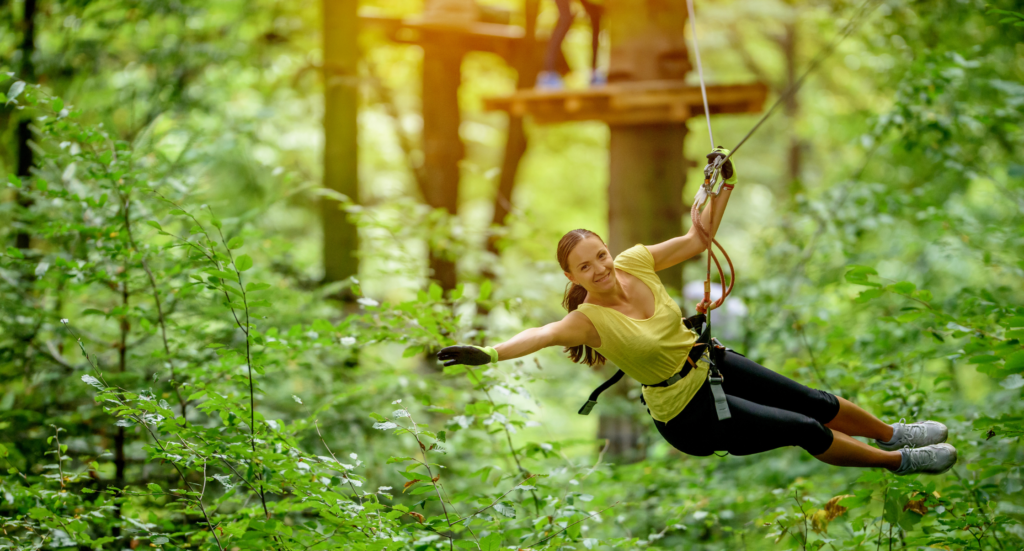
Which Zipline Destinations Are Actually Worth the Drive?
Should You Tackle Monteverde’s Cloud Forest Cables?
Monteverde claims the title as Costa Rica’s original zipline destination, and for good reason. The cloud forest environment creates a mystical experience as you soar through mist-covered trees draped in epiphytes and bromeliads.
The terrain here is challenging—steep mountain roads that require 4×4 vehicles during the rainy season. But the payoff is extraordinary. Monteverde’s ziplines traverse primary cloud forest where quetzals, three-wattled bellbirds, and over 400 other bird species make their home.
Best tours in Monteverde:
- Selvatura Canopy Tour: 15 cables up to 2,500 feet long
- Sky Adventures: Combines ziplines with hanging bridges
- Original Canopy Tour: The first zipline tour in Costa Rica, still operating
The roads to Monteverde can be rough, especially during the rainy season (May-November). A 4×4 vehicle is highly recommended, and the drive from San José takes about 3.5 hours on winding mountain roads.
Is Arenal Really the Best Place to Zip with a View?
The Arenal area offers ziplines with the iconic volcano as your backdrop—when it’s not hidden by clouds. The landscape here is different from Monteverde: secondary rainforest mixed with open areas that provide spectacular views of Arenal Volcano and Lake Arenal.
What makes Arenal special is the variety. You can combine ziplining with hot springs, hiking to waterfalls, and wildlife watching all in the same day. The terrain is less challenging than Monteverde, with better road access year-round.
Top Arenal zipline experiences:
- Sky Adventures Arenal: 7 cables with volcano views
- Mistico Arenal Hanging Bridges: Combines ziplines with suspended walkways
- Ecoglide Arenal: Longest cables in the area, up to 2,400 feet
The drive to Arenal from San José takes about 3 hours, with good road conditions most of the year. From Liberia Airport, it’s about 2.5 hours through generally well-maintained highways.
Why Choose Manuel Antonio for Your First Zipline?
Manuel Antonio’s ziplines offer something unique: the chance to zip from rainforest canopy to views of the Pacific Ocean. The tours here are generally shorter and less intimidating than mountain locations, making them perfect for families or first-time zipliners.
The big advantage of Manuel Antonio is convenience. It’s only 3 hours from San José, the roads are excellent, and you can combine ziplining with beach time and wildlife viewing in the national park.
Manuel Antonio zipline highlights:
- Midworld Canopy Tour: 10 platforms with ocean views
- Manuel Antonio Nature Park: Wildlife sanctuary with ziplines
- Rainmaker Conservation Project: Combines conservation education with adventure
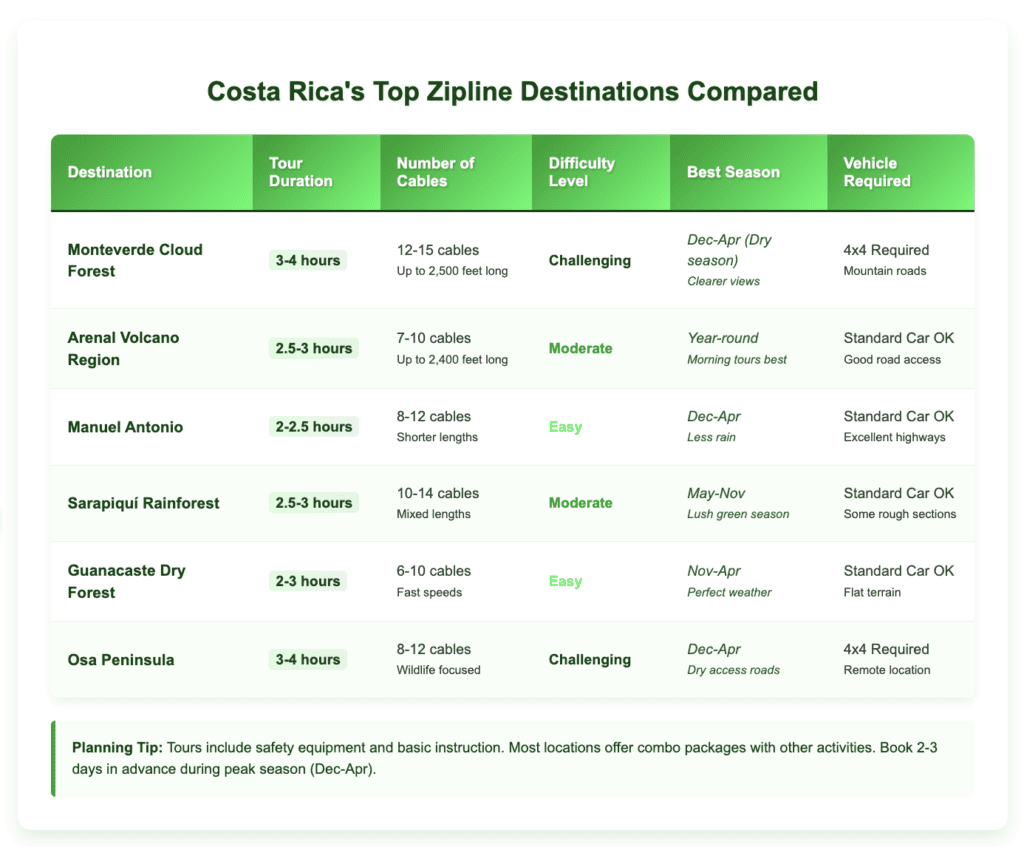
What Really Happens During a Zipline Tour?
What Should You Expect at the Safety Briefing?
Every reputable zipline tour starts with a comprehensive safety briefing. You’ll learn proper body positioning, braking techniques, and what to do if you get stuck on a cable (it happens, and it’s not a big deal).
The equipment fitting is crucial. Harnesses should be snug but comfortable, helmets properly adjusted, and gloves fitted correctly. Don’t be shy about asking questions or requesting equipment adjustments—your safety depends on proper gear.
Essential Spanish phrases for zipline tours:
- “¿Está seguro?” (Is it safe?)
- “Más despacio, por favor” (Slower, please)
- “¡Pura vida!” (What you’ll be shouting mid-zip)
Will You Actually See Wildlife While Zipping?
Your first cable will likely be shorter and slower—a confidence builder. Most tours start easy and build up to longer, faster lines. The longest cables in Costa Rica stretch over 2,500 feet and can reach speeds of 40+ mph.
The views are incredible, but here’s something guides don’t always mention: you might not see as much wildlife as you expect. Animals tend to avoid the noise and activity of zipline tours. The real reward is the unique perspective of the forest canopy and the adrenaline rush of the experience itself.
Weather plays a huge role in your experience. Morning tours often offer clearer views and calmer conditions. Afternoon tours during the rainy season might encounter sudden downpours, which can actually make the experience more exciting (tours rarely cancel for light rain).
Who Shouldn’t Try Ziplining?
Most zipline tours have weight restrictions, typically 80-250 pounds. Age restrictions vary, but many tours accept children as young as 8 years old on shorter cables. Pregnant women and people with heart conditions, back problems, or fear of heights should skip ziplines.
The biggest safety factor isn’t the equipment—it’s following instructions. Guides will teach you specific body positions for different cables. Some require you to brake yourself, others have automatic braking systems. Listen carefully and ask questions if you’re unsure.
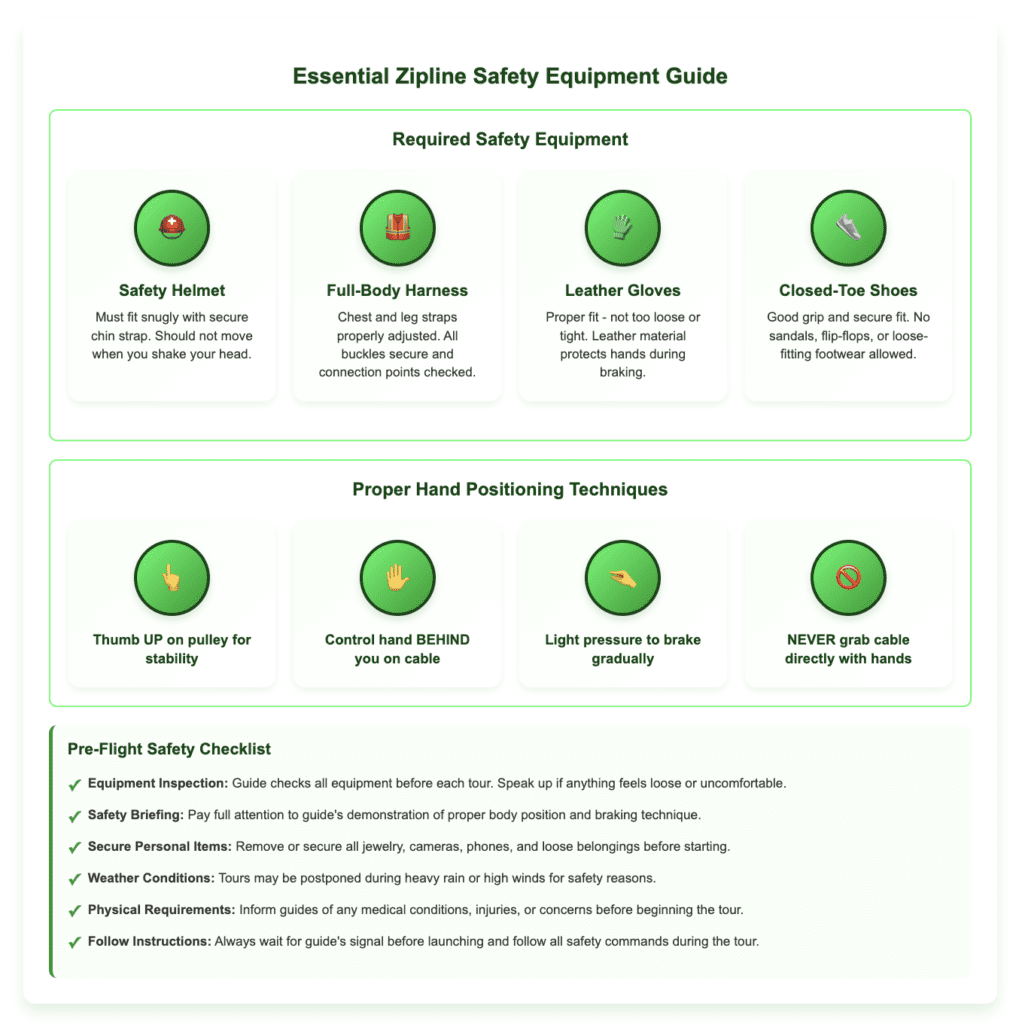
When’s the Best Time to Go Ziplining?
Is the Dry Season Really Better for Ziplines?
The dry season (December-April) offers the clearest views and most comfortable conditions. You’ll have better visibility of surrounding landscapes and wildlife, and equipment stays dry and well-maintained. This is also peak tourist season, so book in advance and expect higher prices.
The downside? Dust on some tours and less lush vegetation. The forest is still green, but not as vibrant as during the rainy season.
Why Do Locals Prefer Green Season Ziplining?
The rainy season (May-November) transforms the landscape into a vibrant green paradise. The forest is at its most beautiful, waterfalls are flowing, and you might encounter light rain during your tour—which many people find adds to the excitement.
Morning tours during the rainy season often provide the best of both worlds: lush scenery with clearer skies. Afternoon tours are more likely to encounter rain, but reputable operators provide rain gear and rarely cancel unless conditions are dangerous.
Road conditions to zipline locations can be more challenging during the rainy season, especially to mountain destinations like Monteverde. A 4×4 vehicle becomes essential rather than just recommended.
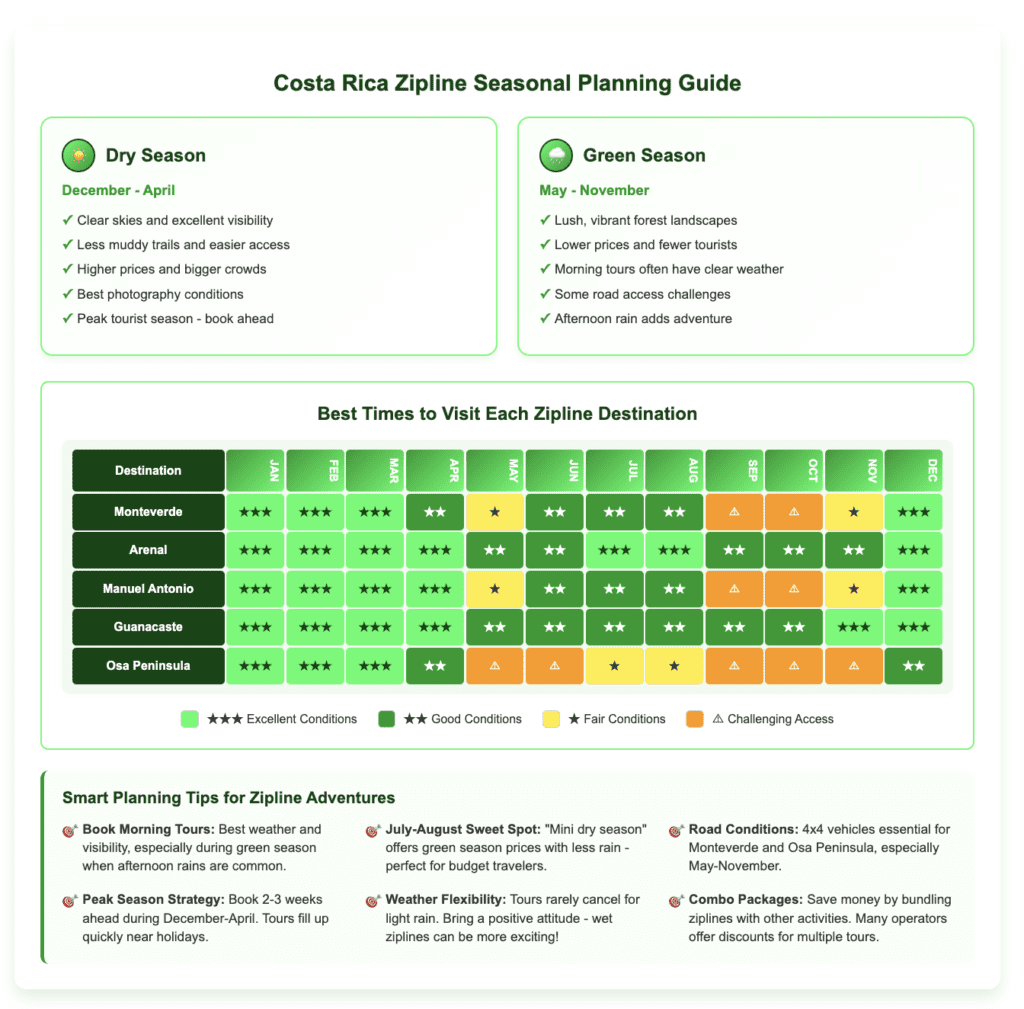
How Do You Actually Get to These Zipline Locations?
Can You Reach Monteverde Without a 4×4?
The route to Monteverde involves about 30 kilometers of unpaved mountain roads. During the dry season, a standard car might make it, but it’s not recommended. During the rainy season, 4×4 is absolutely essential.
The drive from San José takes 3.5 hours, including about an hour on rough roads. From Liberia Airport, it’s about 3 hours with similar road conditions at the end.
Which Zipline Areas Have the Easiest Access?
Roads to the Arenal area are generally good year-round. From San José, it’s about 3 hours on paved highways with only minor rough sections. From Liberia Airport, the drive takes about 2.5 hours, mostly on well-maintained roads.
Most Arenal zipline tours are easily accessible with standard vehicles, though some remote locations might require 4×4 during the rainy season.
Manuel Antonio has the best road access of all major zipline destinations. The drive from San José is about 3 hours on excellent highways. Standard vehicles are fine year-round, and most zipline locations are easily accessible from the main coastal highway.
Having your own vehicle gives you flexibility to combine ziplines with other activities and explore at your own pace. Many zipline locations are in remote areas not well-served by public transportation.

What Else Can You Do After Ziplining?
Which Activities Pair Best with Morning Ziplines?
Costa Rica’s compact size makes it possible to combine ziplines with other activities in a single day:
Arenal combination options:
- Ziplines + hot springs
- Ziplines + La Fortuna Waterfall hike
- Ziplines + wildlife sanctuary visit
Monteverde combinations:
- Ziplines + hanging bridges
- Ziplines + coffee plantation tour
- Ziplines + night wildlife walk
Manuel Antonio combinations:
- Ziplines + national park visit
- Ziplines + beach time
- Ziplines + wildlife sanctuary
Should You Pack Everything into One Day?
Most zipline tours take 2-4 hours, leaving plenty of time for other activities. Morning zipline tours often work best, as afternoon weather can be less predictable during the rainy season.
If you’re staying in one location for several days, consider spreading activities across multiple days rather than cramming everything into one exhausting day.

How Do You Pick a Safe Zipline Operator?
Costa Rica has developed strong safety standards for zipline operators, but not all tours meet the same standards. Look for operators that are members of the Costa Rican Tourism Board (ICT) and have appropriate insurance coverage.
Red flags to watch for:
- Tours significantly cheaper than others in the area
- Equipment that looks worn or poorly maintained
- Guides who don’t provide thorough safety briefings
- Operations that seem disorganized or rushed
Good signs:
- Modern, well-maintained equipment
- Thorough safety briefings in your language
- Guides certified in first aid
- Clear emergency procedures
- Positive recent reviews from multiple sources
What Are the Best Tips for First-Time Zipliners?
Can You Really Take Photos While Zipping?
Most zipline operators allow cameras, but securing them properly is essential. Use a camera strap around your neck and wrist, and consider a GoPro or similar action camera for hands-free operation.
The best photos often come from platforms between cables rather than during the actual zipping. Take time to enjoy the views and capture the surrounding landscape.
What If You’re Scared of Heights?
It’s normal to feel nervous before your first zipline. The anticipation is often worse than the actual experience. Start with shorter cables to build confidence, and remember that you can ask to skip any cable that makes you uncomfortable.
Guides are experienced at helping nervous participants. Don’t hesitate to ask for extra instruction or reassurance—they want you to have a positive experience.
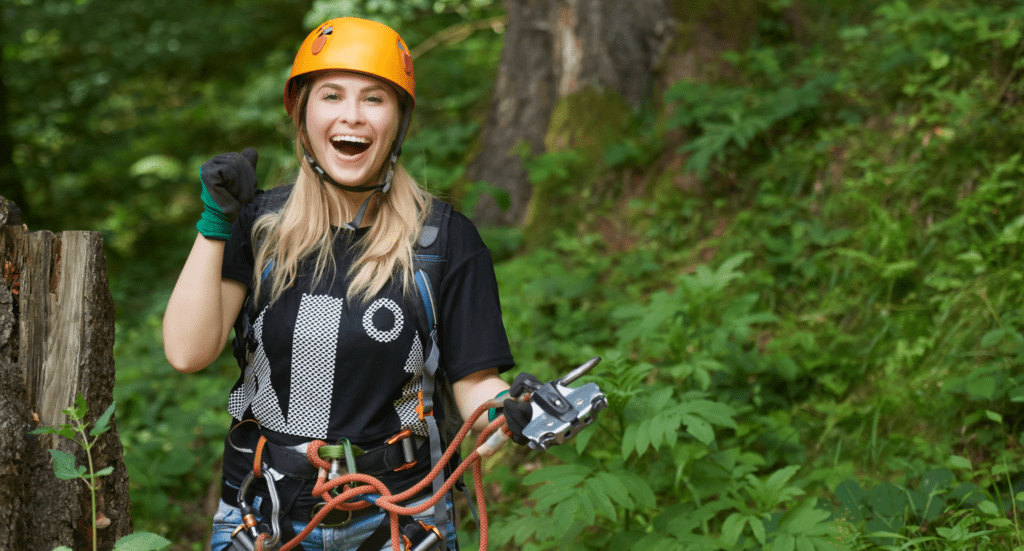
Ready to Take the Leap? Here’s Your Action Plan
Ready to add some excitement to your Costa Rica itinerary? Here’s how to make it happen:
- Pick your spot based on your comfort level with road conditions and what else you want to do that day.
- Book ahead at least a few days in advance, especially during dry season or holidays.
- Sort out your wheels to reach your chosen zipline location—many of the best tours are in areas requiring 4×4 access or long drives on mountain roads.
- Pack smart with closed-toe shoes, comfortable clothes, and secured camera equipment.
- Show up ready for an incredible experience that will give you a completely new perspective on Costa Rica’s incredible forests.
Whether you choose the misty cloud forests of Monteverde, the volcanic landscapes of Arenal, or the coastal views of Manuel Antonio, you’re in for an adventure that showcases Costa Rica’s natural beauty from a perspective that few people ever experience.
The forest canopy is waiting—and the views from up there are even better than you imagine. Just make sure you can get there safely and comfortably, because the journey to these remote zipline locations is definitely part of the adventure.
The trees are calling, and those views from the canopy will stick with you long after your feet are back on solid ground. Time to answer that call!




